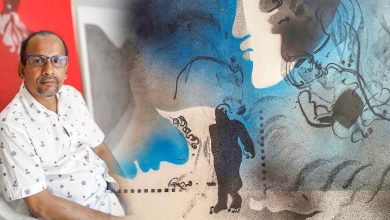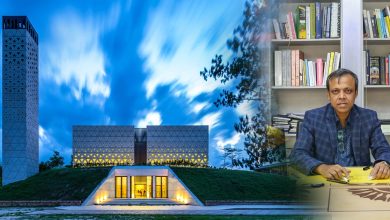For the 5th Anniversary issue, the fellow advisors of Showcase magazine, Professor Shamsul Wares and Ar. Mohammad Foyez Ullah have selected a jury panel of 5 members: Saiqa Iqbal Meghna, Mohammad Emran Hossain, Rashed Chowdhury, Mohaimeen Islam and Didarul Islam Bhuiyan, in the architecture and interior sector to select 10 names out of many successful projects.
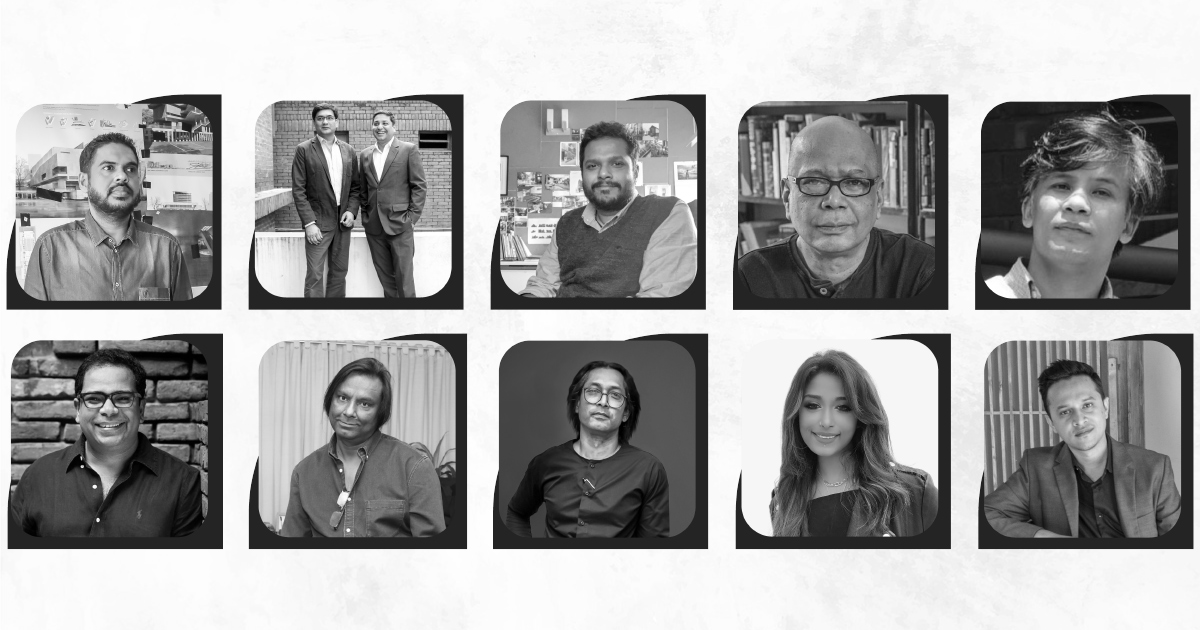
As difficult as it was for the jury members to shortlist architecture and interior designs, it was a successful compilation nonetheless. The criteria for selection were to cover sub-fields of architecture domain — residential, institutional, health-care, and commercial. As for interior design, unique works that evoke certain sense of relatability in the contemporary scene was the prime idea behind it.
Archeground Ltd. – Shahabuddin Foundation School
The Shahabuddin Foundation School Complex built in a rural setting of Lakshmipur, Chandpur, is designed to tread lightly and with minimal impact on the surrounding landscape. Designed by architecture firm Archeground Ltd, the scale of the construction, the selection of materials, and the arrangement of the site all focus on creating a unique experience for the children attending the school and community, being mindful of sustainability and development issues.
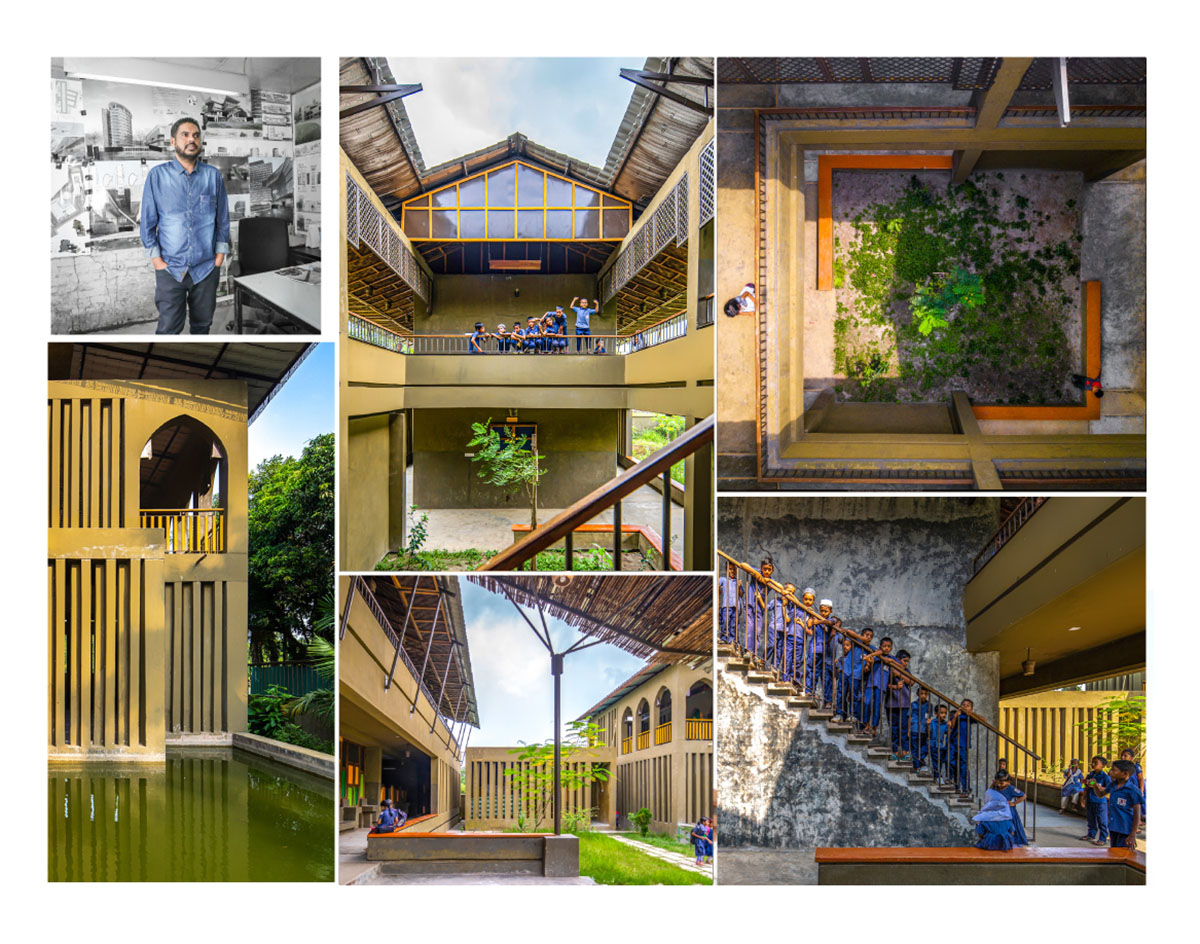
Constructed on an area of 785.6 square-meters, the school is designed to embrace the tropical expanse and that pay homage to the traditional architecture of Bangladesh. Being inspired by traditional architectural forms, a one-storied ‘do-chala’ structure with a central courtyard (uthan) has been incorporated in the design. Semi-outdoor classrooms, office rooms and service spaces are arranged on the ground floor. Other classrooms are placed on the first floor which seamlessly connects with the ground level by an inviting straight flight stair. A mosque is designed at the west of the site that acts as an active social platform. From architect Lutfullahil Majid, lead architect of Archeground Ltd, village children are familiar with local vernacular living and a school built with respecting traditional architectural forms will provide children to develop a sense of belonging with the place.
The school is built and collaborated with local artisans and not only was this approach the most affordable and employed local skills, but it also helped to create a sense of ownership and pride within the community. To achieve the earth-like scheme of the traditional expression, a customized plaster is used as a wall finish. Cement and pigment have been used to make the wall finish and later on a layer of adhesive are applied over it for weather protection. Traditional handmade bamboo woven panels with wooden frames are used for the ceiling. Functional spaces are divided by brick walls and a perforated bamboo screen. All the structural elements consisting of finished floors, framed walls, perforated screen, roofing structure are built on-site employing local resources to make it cost-effective and energy-efficient.
DWm4 Architects – Noor Residence
Designed by DWm4 Architects, the Noor residence located at Nobigonj, Narayanganj, is an attempt to reconstruct memories – memories of the family of a septuagenarian mother and her six children who occasionally lived on the same site about 40 years ago. Therefore, to bring back the olden memories, the house is not conceived as a composition of three-dimensional forms – rather as a container of a sequence of experiences that negotiate with surroundings in terms of form-space enclosure.
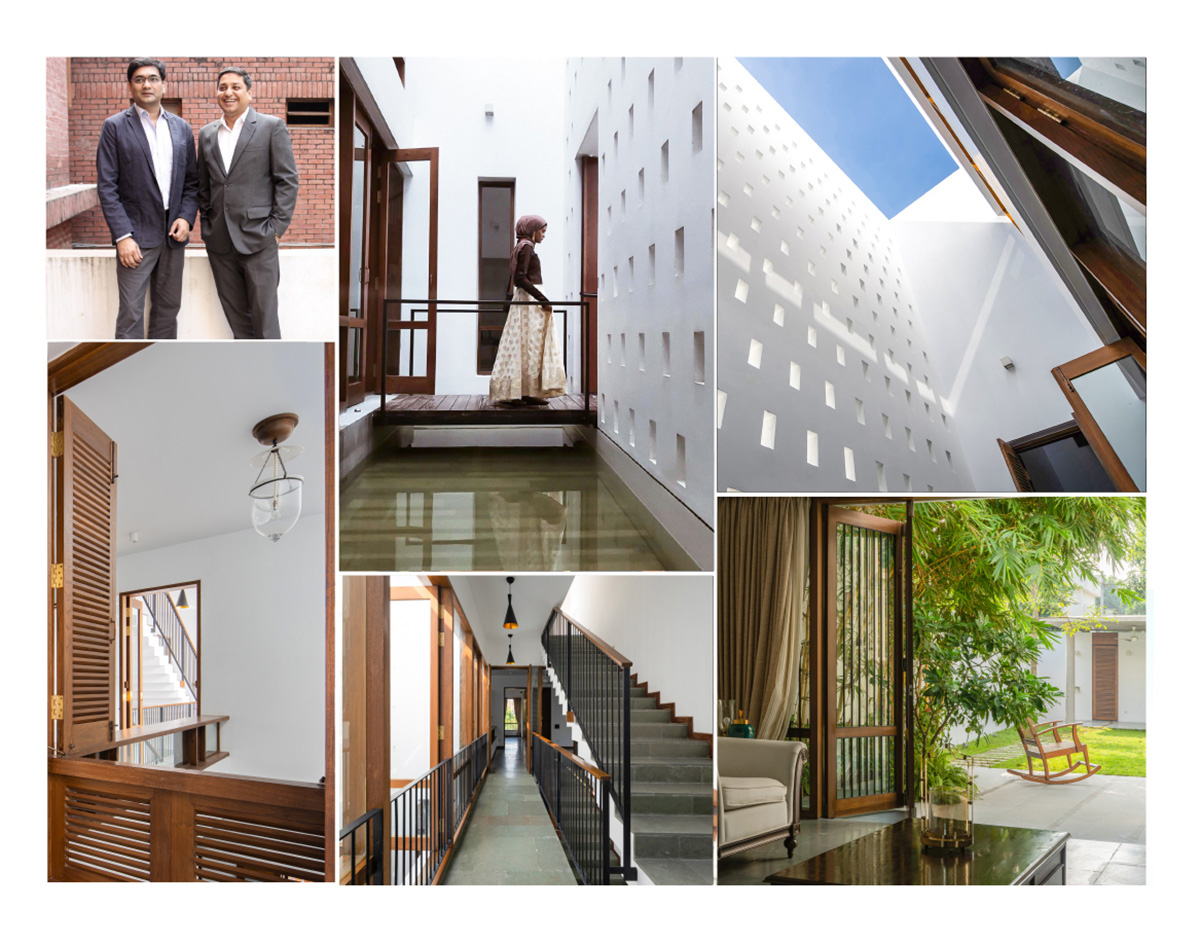
The vertical zoning of the essential spaces was derived from what would be the lifestyle and habits of the inhabitants during their stay there. Almost every other week, the mother will be coming over from her regular place of abode in faraway North Dhaka. Her room needed to be at the ground level, with an adjacent space for meet up and long conversations, after which many of the visiting persons would stay back for lunch, and up to dinner. The dining room, hence, is in closest proximity. The living room is set apart through the introduction of a pair of double-height intermediate volumes. These also create a subtle distance from the neighbouring building, while bringing in light and air. The face of the double-height spaces is a wall with perforations – its geometry is reminiscent of the ornamental pattern of a hand-woven cotton saree that can simultaneously refer to the times of the 1970s as well as the present. This wall is like the cover page of the house, the giver of light and air, the centre that holds the vertical spaces together – it is the tribute to the mother.
In terms of form, the two-storied lower volume on the lawn is connected with the three-storied volume through the light-well and staircase. The light-well, which is also the formal entry, with its perforated wall, water body and the small wooden bridge above, is the hub of the house itself and is designed to be a spatial multitasker. It had been an important consideration in the design development stages that the mass does not overpower the neighbours’ houses in scale, and is expressly a statement of decent, humble, aesthetic infill.
River and Rain- Himchori Residence
Seamlessly camouflaged with the natural beauty of Cox’s Bazar, Himchori Residence is a dream house that serves the family of Mr. Arshad Jamal and Ms. Shahria Sharmin as a sentient space for vacation where they can immerse themselves in the tranquility of the surrounding. The two-story villa is designed by Kazi Fida Islam, Architect of “River and Rain Ltd.”
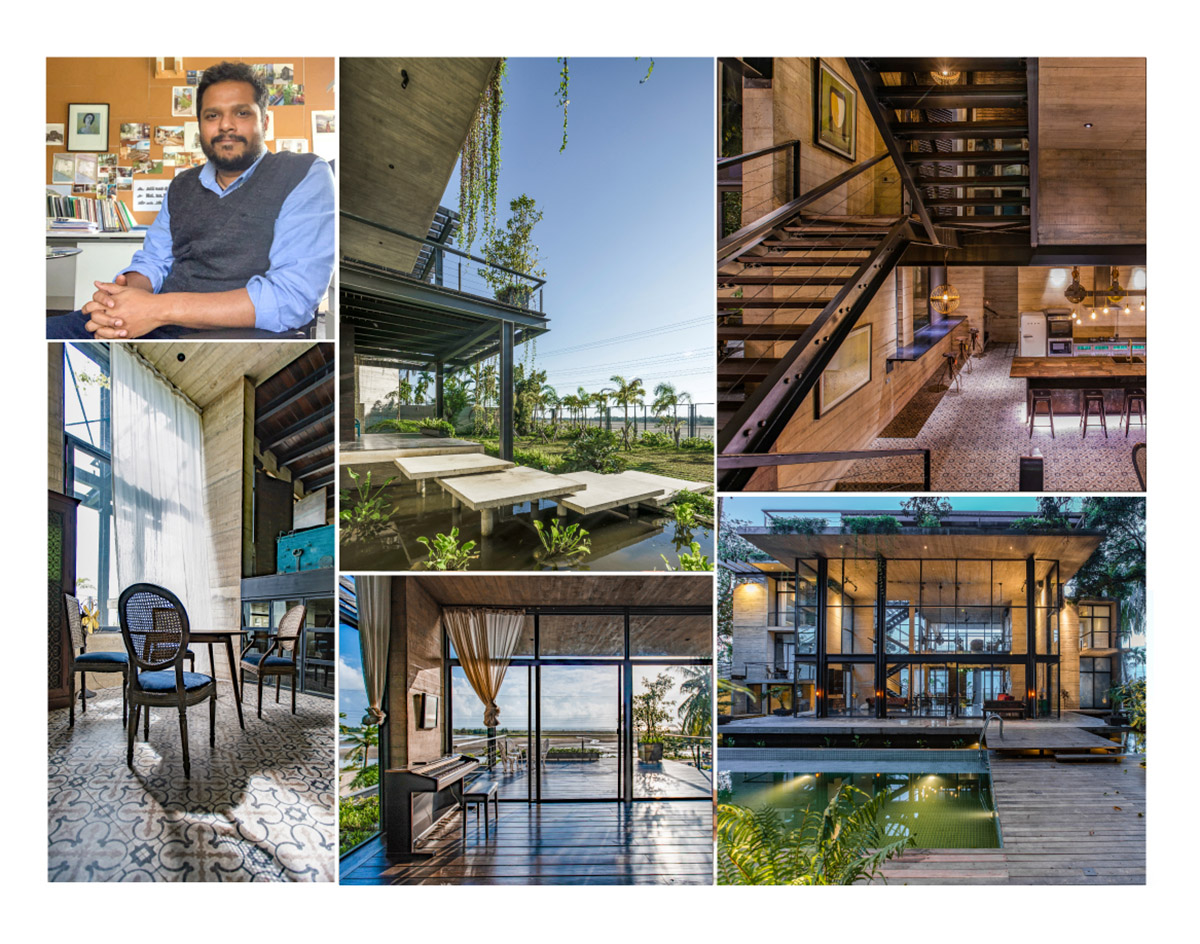
The project started taking shape with a design process from the year 2016 and took its final form after construction in 2017. The site of 1414.10sqm is in the picturesque location of Cox’s Bazar, adjacent to the hills as backdrop and a merely further vivid sea. This very majestic outline and closeness of the harmonious blue vastness acted as the sole inspiration and guide to form the concept on which the design was created. The architect conceptualized the project to frame the view rather than hinder it. The design of the spaces took its shape in alignment of the horizontality of the sea and the verticality of the hills.
Composite structure was used to portray the formal expression with steel structure and RCC construction. Innate colours of the cladding materials were kept intact. The rawness of the material and construction gave the fair-faced concrete wall its texture, using the saw cut 6” garjan wood shuttering. The composition of the whole residence of 840.72sqm was focused with the main stair as the spine, connecting all spaces with all the celebration from inside and out, spiraling down each flight. This simple stair is the soul of the residence. The abode encompasses the nature within where rain can play its acoustic tune against the corrugated sheet roofing, light and shadows dance along the day with shift in sun path and the greenery, reflected on black polished marble, puts life into the floor. The interior follows a rustic tone, amplified with the combination of antique furniture, various type of marbles, antique toned wood etc. that complements the exterior and interior colour compatibility.
The whole residence was designed with details taking into account the weather and climate of the Himchori area. Consequently, constant improvisation was required in lessening the site damage while maximizing the retention of the existing natural ecosystem of the environment which was an important factor as well as a dominant issue. The residence flourished amidst the natural element with its uniform sublime finishing.
Saif Ul Haque Sthapati – Arcadia Education Project
Recipient of the prestigious Aga Khan Award for architecture in 2019, the floating school in south Kanarchor established by the Arcadia Education project, strives to elevate people’s lives, contributes to social and economic development, and provides a pathway to solutions for the global issues of rising water levels and access to education in rural communities.
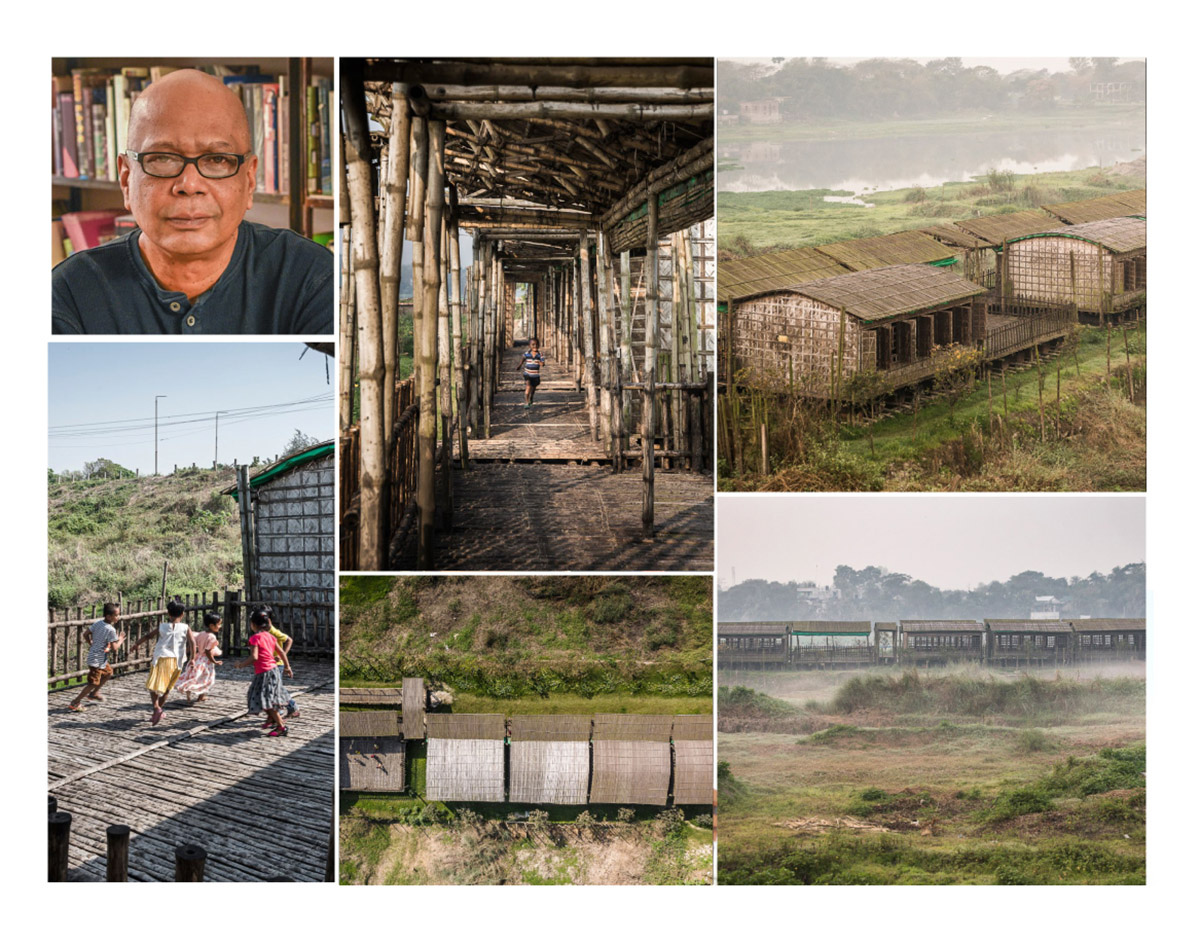
The site is a riverside plot on which the school is built. During the monsoon season, the land is over-flooded under almost three meters of water for a third of the year. Rather than disrupting the ecosystem to create a stabilized mound for building on, or erecting a structure on stilts that would have been too high in the dry season, architect Saif Ul Haque who was appointed for this project, devised the solution of an amphibious structure, anchored to the site, that could sit on the ground or float on the water, depending on the seasonal conditions. The building footprint was levelled using retaining walls of sandbags with sand, earth and local brick infill, and used tyres fixed atop for cushioning. Bamboo posts sunk 2m into the ground serve as anchoring points for the school’s various independent but interconnected rectangular structures that consists three multi-purpose spaces used mainly as classrooms, an open-topped platform for office space and the other structure for service usage. Built of three types of bamboo, they are kept afloat by substructures of used 30-gallon steel drums within bamboo frames.
Sheikh Ahsan Ullah Mojumder and Associates – Unity Complex
The Unity Complex in Satarkul, Dhaka, designed by Sheikh Ahsan Ullah Mojumder and Associates aims to create a harmonious architecture that does not disturb the existing physical texture and landscape pattern rather enhances the environment quality being at an interdependent and coherent existence. The perforated surfaces made by concrete ribs with ivies and creepers, the fluid interior spaces merging with the outdoor greeneries and water, break the rigidity of the geometrical form – combining and blending it with the surrounding nature.
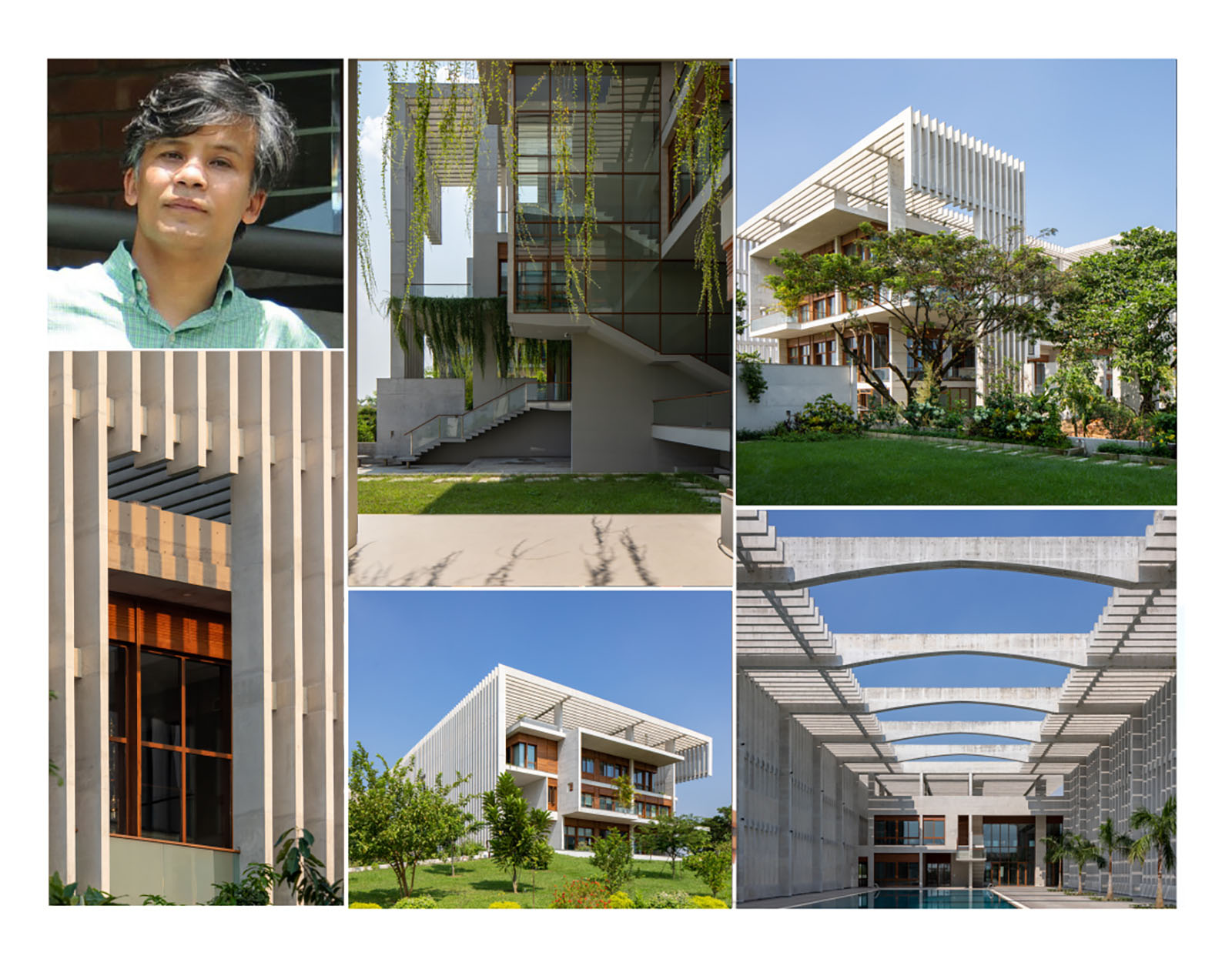
This design idea focuses on the spirit of home and evolves considering the conventional family values as the standard or prototype. “A family becomes successful when inter and intra generation bondage is created and a strong connection exists in their education, knowledge, wisdom and belief that helps them to grow as independent and interdependent individuals simultaneously. Ample scopes of interaction promote this bondage and connection. This idea influenced and shaped the conceptual framework of the design”, says architect Mojumder.
Upon entering the foyer/entry lounge on the first floor, one finds visual freedom and experience a fluidity of space stretching from different interlinked layers of spaces around the central loft of space to the lush landscape outdoors, past the water body and lawn up to the lake at the eastern end of the complex. The lounge is aligned with the formal living area at the south and leads toward the guest rooms located at the north by a connecting bridge. A staircase from the lounge guides one below to the ground floor containing the primary interactive space and utility/service areas and above to the more private living quarters of the residents. The focal point of the house, which is the dining space, is located centrally on the ground floor. The second and third floor consists of the living zones for the three generations of the user family, defining their territory and at the same time keeping them connected with the central common space.
A residence is an ever-changing phenomenon transforming with the living patterns of its users and time, thus finally being in unison with them. Traditionally the people of this region are emotionally driven and their spiritual entity is much dominant than their rationale. So a sun-dappled place to evoke contemplation, a murmuring cadence of water-body to nurture their soulful existence was intended.
Urbana- Friendship Hospital
Friendship Hospital, located in Shyamnagar Upazila of Bangladesh and designed by Architect Kashef Mahboob Chowdhury of Urbana in 2018, breaks that monotonous design grid and brings life to the hospital.
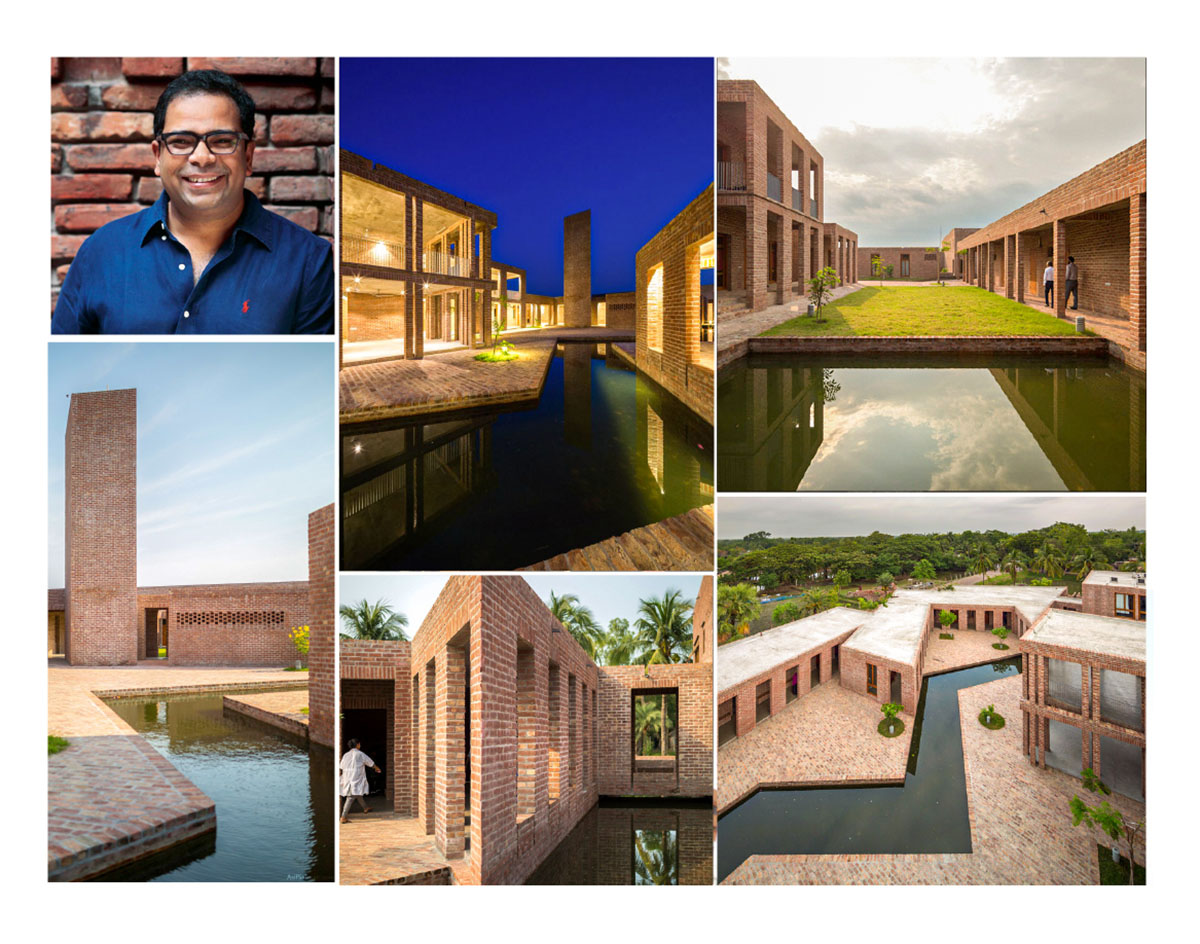
The eighty-bed hospital of 3387 m² area is built on land, given by a benefactor to Friendship NGO, where the surrounding rural population was heavily affected by a major cyclone just a few years ago. The architect developed the design with sensitivity towards the program and respect for the site location and its people. The architecture blends characteristically with the undisturbed natural surrounding with indistinct low-rise structure and thatched houses.
From the very initial phase of design, the demand of inpatient and outpatient departments parted the site according to the zoning. The zigzag layout of the design is an abstraction of the riverine landscape, a distinctive portrayal of the country, and is efficient without any compromise of the requirement of hospital facilities. The imitation of the landscape, with the meandering canal along the site in the design, not only acts as a container for rainwater harvesting but also serves to meet the requirement of access barrier while maintaining the visual connection. As a result, it brings the whole space together as well as provides fresh water in an area with unusable, saline groundwater. Spaces with sensitive functions with controlled environment, such as operating rooms, are placed under wind shadow with air-conditioned enclosure whereas the rest are facilitated with ample natural ventilation and light, brought in with the arrangements of open courtyards. These courtyards, which were initially supposed to be interconnected, are laid out separately as such to provide the necessary access control at various points. Moreover, the consulting rooms and wards are painted with the playfulness of direct-indirect sunlight and shadow, lifting the spirit of the environment.
Friendship Hospital is an exemplary work that combines the architectural requirement and aesthetic and balances that with that of nature and surrounding and nurtures the spirit of life, landscape and the inhabitants at the very core of the design concept.
Vistaara- Rangs Babylonia
Dhaka is a growing cosmopolitan city with uncontrolled urban grain that is growing defying the truth of scarcity in land, energy and continuingly deteriorating environment. Located in Tejgaon, a bustling part of this capital of tedious structures, Rangs Babylonia is a unique and coveted commercial complex of Rangs Properties Limited that is sure to turn heads with its integrated as well as synergic design approach by architect Mustapha Khalid Palash.
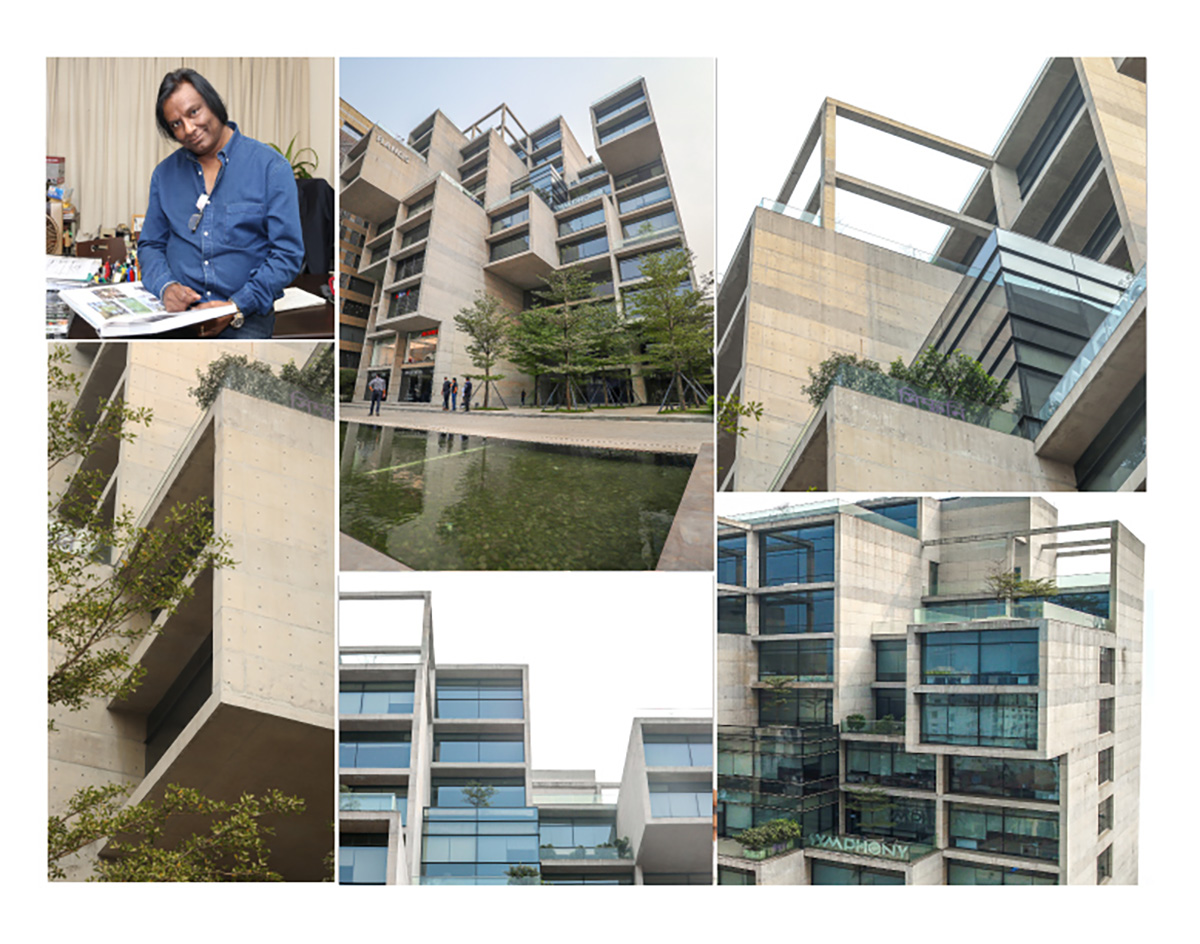
The Construction and operation of buildings have a hugely active and passive impact on the environment as it is an integral component of the urban fabric. Placed in the strategic location that is a prominent business hub connected with the other important areas, Babylonia strives in incorporating green fencing, vegetation and green landscaping around the buildings to revive the lost greenery in the city.
The form of the building developed with a series of laterally-extruded blocks that creates various indoor and outdoor spaces, changing with levels. The bold geometric expression of the structure is complemented with the minimalistic use of rugged and fair-faced concrete exterior and glass. Standing on a large plaza, the frontier of the edifice executes a balanced ambience with water bodies and a touch of greens. This fifteen- storied avant-garde architecture is articulated to allow light and ventilation by inserting double-glazed glass with extended side to block the extreme heat and glare of east and west. The in-house construction and design team of Rangs Properties Limited worked along with Vistaara Architects for successful completion of the structure compiling unique construction methodology which includes usage of celluloid paper, proper shutter preparation after lubrication, forced mechanical ventilation in the basement etc. as well as the detailing such as high COP based VRFs and choice of plants.
The project is a paradigm shift in the architectural realm of commercial building that dwells to maximum sustainability and minimizes the impact on the environment amidst the urban fabric that is being etched with the growth of spawning built forms.
Atelier Robin Architects – Cafe Mango
In the vein of its previous locales, the much revered Cafe Mango has been built on the idea of ‘presence of absence’ in its newest address in Gulshan 1. Instigated with simplicity and contrast by owner and architect Salauddin Ahmed Patash, the place reveals the honesty it possesses in each layer of its design.
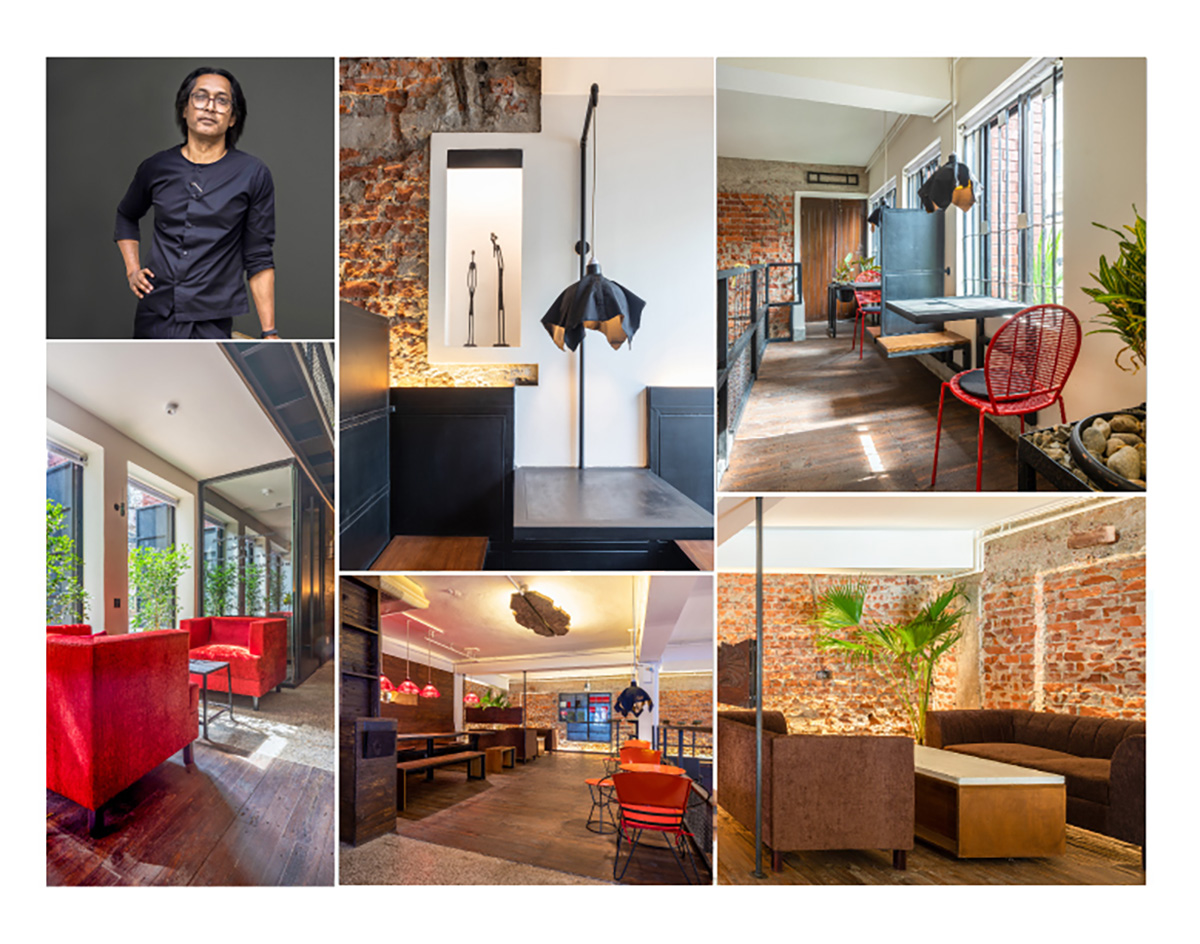
Cafe Mango had emerged as an attempt to bring forth public living rooms in Dhaka, a city that thrives on untold complexities. Salauddin Ahmed considers designing Cafe Mango a creative discovery rather than a creative journey and thus, has never shied away from discovering neglected pieces of the city, full of potent possibilities and untapped beauty. Similarly, his recent intervention is situated in one of the darkest corners of Gulshan, historically. Instead of changing the course of history, he wanted to reinterpret the idea of the location and aspire the neighbours to come out. The design process of the place was quite organic as it was the feedback of the context, environment and desire of the place.
Customizing new design elements and recycling and repurposing some old, Cafe Mango instils a sense of place where one can indulge, heal the mind and body, and discover the blend of both old and new. The 2400 sqft double-height space had an abundance of scope to be innovatively explored. Before one enters the space, a solid black steel door inflicts an element of surprise. Small glimpses of the interior can be viewed from the sideways but one has to come inside to fully unravel what the place holds. Upon entrance, the place has a welcoming yet intimate undertone where one can breathe in, not breathe out. A myriad of seating arrangement can accommodate around 100 people. The handcrafted long bar table on the ground floor takes inspiration from Leonardo da Vinci’s famous painting ‘The Last Supper’.
On closer inspection, one can observe the great attention to detail given by Salauddin Ahmed in each corner. His accumulated collection of reclaimed furniture, artworks and artefacts add a touch of personality to the space. Curated elements like window panels, small bamboo models, Buddhist sculpture etc serve as points of interest and subvert the overall interior design direction. Even the facility toilets have been painted with vibrant rickshaw art by local rickshaw painter Pappu. In many ways, the design of Cafe Mango is an ode to local craftsmanship that promotes the work of traditional artisans. “I’m keener to make others understand the people who are involved in these jobs. I will quietly introduce and reveal them to you through my design”, explains Salauddin Ahmed.
Hive Interiors – Icon Tower Showflat
Located in the epicenter of the capital’s Gulshan Lake, the interior of the residential complex Icon Tower merges harmony of luxury and affordability, while promising an iconic lifestyle with the sumptuous interiors which have been meticulously planned with versatile layouts, wide dimensions and finest materials by Hive Interiors.
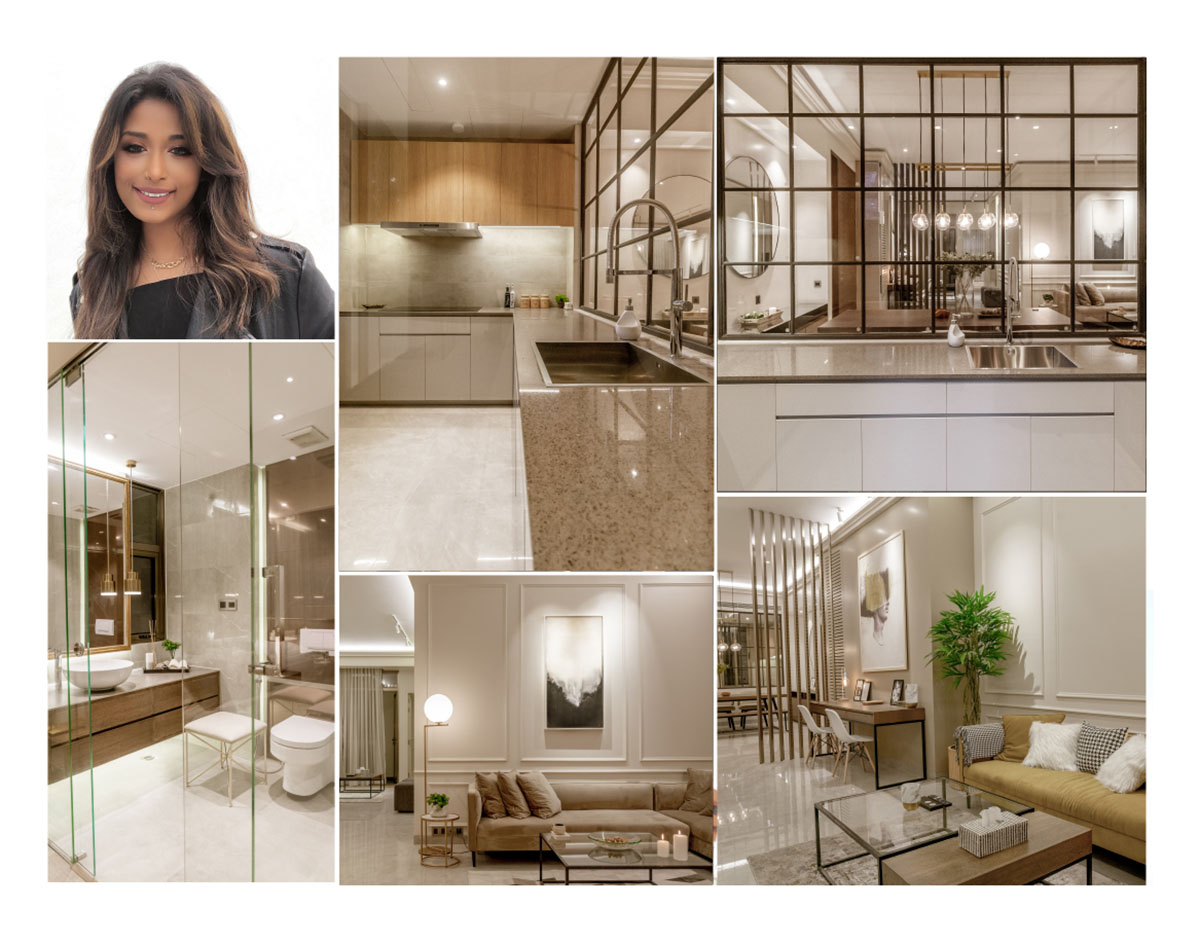
The residential tower has a total of 25 rental flats, where single units are 2150 square-feet but many of the dwellers have also combined flats to turn them into simplexes and duplexes. This residential complex notably introduced the first show-flat ever in Bangladesh. For the interior of the show-flat, Shevi, lead interior designer of Hive Interiors, opted for a contemporary neo-classical design for a sophisticated aesthetic with a transitional design incorporated with modern materials, such as brass and glass, and united them with plush furnishings. It took the design team about six months to fully complete the project from the conception to the execution.
“We wanted to create a unique customer experience and made many experiments prior to the execution of the show-flat. We studied and researched on multiple show flats and opted for a simple yet elegant interior interlaced with classy materials for each area. Since it is an open plan project, we carefully curated each area; that to put in simple words, the ‘wow factor’ as soon as an occupant enters. The space is then sectioned off partially with brass screens to zone it off as the family-living area and study space”, explains Shevi. The flat has a combination of dove white and mocha colours on the walls. The living spaces are covered in light beige, marble finish tiles and the bedrooms have light oak coloured HDF flooring.
The simple interiors and efficiently organized space allow the dwellers to avoid unwanted distractions and focus on recovering physical and mentally from a day’s challenges. All in all, this residential complex is the perfect combination of style and diverse elements, which piece together to create an inviting and serene home.
Inked Studios- Kensho
The famous Brazilian architect and one of the key figures in the development of modern architecture Oscar Niemeyer, in regard to his work says— “My work is about “form follows beauty” or, even better, “form follows feminine”
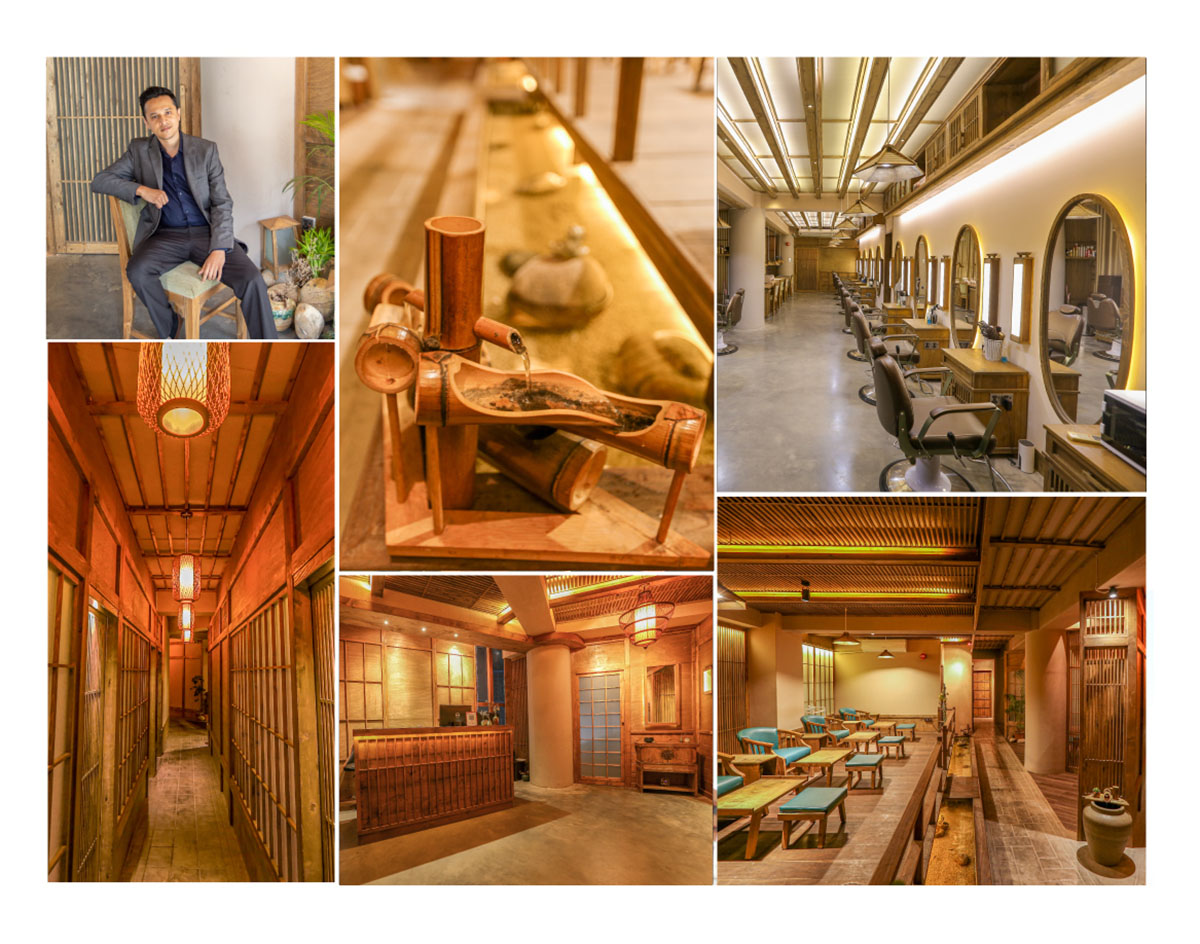
This perception of a soothing feminine beauty seems to seep in into the structure of the luxury salon spa, Kensho. The word Kensho is a Zen concept which if deconstructed means the pure realization of the beauty of solitude through enlightenment and this one of a kind beauty salon at Gulshan, captures the brilliance of concept architecture at its finest. “We could have made something shiny with marble out of this, but we instead we opted for a style that is very down to earth”, says Sabbir Amin, the lead designer of Kensho. One thinks of luxury spots and the image of bejeweled glittery aura fills up their senses, Kensho however redefines luxury by using the jargons of timeless grace, entrenched in eastern aesthetics— subtracting the ominous ostentation out of the equation.
The interior of the space is infused with natural tones and materials such as stone and wood and educes an escape into Japanese minimalism; however not one that is rooted in strict lines of modernism and stringent symmetry but the kind which is inundated with an exotic nostalgia for traditional Oriental paintings. The gentle music along with the flow of natural light adds in to the entire experience of exquisiteness at Kensho.
Another alluring aspect at Kensho is the creative use of space. The design team gave a lot of emphasis on the idea of giving the customers their sense of comfort in their ability to move around freely and not rushing into getting the service. The owner talks about the lack of stairs or any other steep or brutal profiling within the interior; the art of architecture and interior exists while keeping in mind, the comfort lens of feminine beauty and most importantly perhaps, it serves the purpose of creating a safe Zen bubble for the customers, instead of erecting itself as a bedazzled spectacle thus becoming supremely user oriented.


